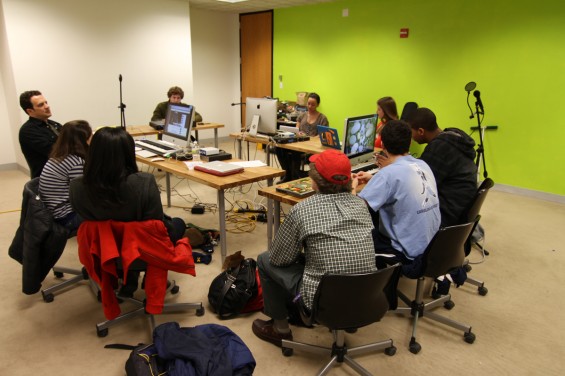
We needed to cover basic recording techniques so everyone could effectively record with a microphone or direct instrument, learn to control virtual instruments with a MIDI keyboard, creatively use effects, and edit and navigate a recording session in Garageband. We had to explore techniques of songwriting in ways that would most quickly lead to inspiration, but also needed to understand some fundamentals of form and convention to give everyone a confident place to start from. The students had to be responsible for a great deal of information in a very short time. We found that fast, hands-on training using familiar styles and cultural references was the most efficient and fun way to have the information take on relevance and stick in the mind throughout the process. I was struck by how quickly we got past the initial instruction stage and into creating music.
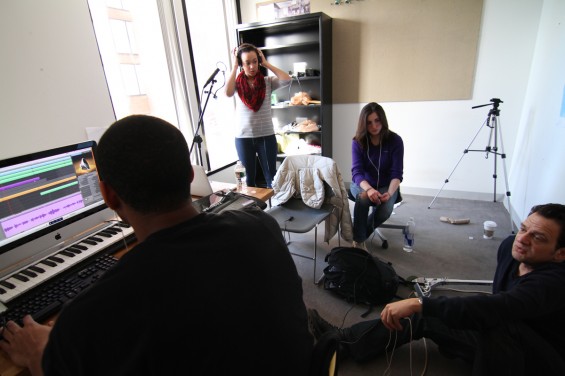
This was the third studio in the trimester and some of students had worked together already. This created some comfort and familiarity, but also created an opportunity for us to shake things up a bit by intentionally grouping some students who hadn't had a chance to work together. There were varying levels of experience, confidence and musical skill coming into this: Some students played instruments to varying degrees of skill (there were a few incredible standouts!), some had written poetry (voluntarily even!), and some had sung somewhere other than the shower...but no one had ever attempted this kind of endeavor, and in many ways, it was equal footing for all. You can imagine the various states of mind in the room in the beginning: curiosity, excitement, and fear. It was critical that we create an environment of support and inclusion in order for everyone to be able to explore and reveal themselves as fully as they could. There was a lot of shyness and some amazing and courageous firsts: singing from people who had NEVER sung before (in front of others or on a recording), powerful, beautiful lyrics from first-time writers, and recording, production and arranging of ideas from people who had never set up a microphone, written or recorded before.
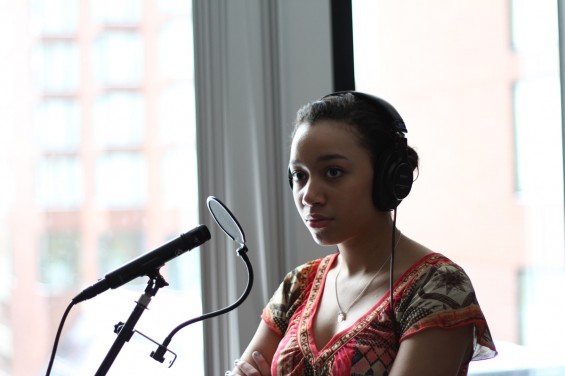
The journey was to be far more important than the outcome, but the outcome (the final projects) would be the clearest path for retracing and understanding the journey in order for the studio to have a lasting impact. Developing this process was a fascinating study of contrasting, yet complimentary paths of applied technique and finding one's own instinctual way. There is more than enough theory and technique to learn about sound, music, songwriting, recording and production to last a lifetime, and we had less than two weeks. The evolution and development that happened in our 7 days together was incredible. (Okay, it was 8 days for the 2 out of 3 groups that came in on the SECOND snow day on their own! Many kudos to those who showed up.) We had only a few general guidelines: Everyone had to meaningfully participate. Each individual in the group would take turns being responsible for the roles of Artist, Producer and Engineer in order to gain a fuller understanding of the various facets of the process. Everyone would take turns getting their way if there was an impasse. At least one group implemented this once. Project Requirements: Large Group Project: Remake of Living On A Prayer Everyone had to contribute at least 8 bars worth of original verse lyrics. Unfortunately we ran out of time to record it! Nonetheless, it was an extremely valuable exercise in lyric writing and certainly helped get the creative juices flowing. Small Group Project: Song must contain an introduction, 3 distinct sections (with noticeable dynamic and instrumental content) and an ending. Each piece must use examples of audio and MIDI recording, editing, virtual instrument and effects, and each team demonstrates an overall ability to create and navigate a session in Garageband. Each piece must contain a vocal component (didn't have to be singing, although all three projects chose to use singing).
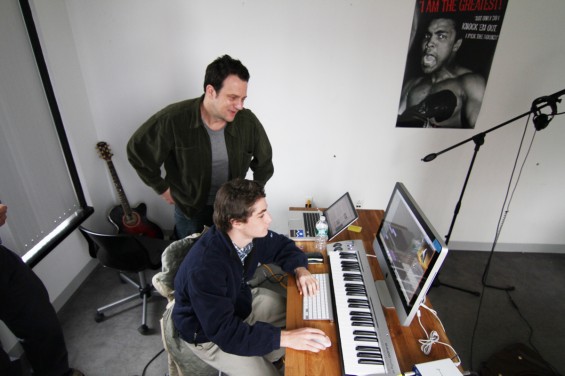
Throughout, we were mindful that music is as much about feeling as anything. This was a recurrent theme that allowed us to get to the deepest core we could in the time given. Music and song easily related to the trimester's theme of Storytelling and we found myriad connections along the way. In the best of circumstances, ours was an ambitious agenda. Among the questions we asked ourselves were: What is it about music that moves us? What drives creativity? How do culture, purpose, time and place influence forms of expression? What are the connections between personal and universal experience? What are functions of the various roles in a writing/recording team? We answered some of this via discussion and listening and most of it by doing. And that was the whole point: To do. Each group has eloquently written their own blog about their group's experience, and they express their intentions and process better than I ever could. Two out of the three groups took the initiative to create wonderful videos to accompany their music. I am deeply grateful for having been able to work with such a wonderfully courageous and talented group and I cherished the experience. This was really not so much about the final product as it was about the journey. It was about lighting the fire. I was assisted by Tufts University senior (and colleague) Nick Gang. His energy and contribution, both creative and technical, were invaluable. Also, many thanks to Saeed, Saba and David for their support and this wonderful opportunity. Adam Steinberg February 2, 2011
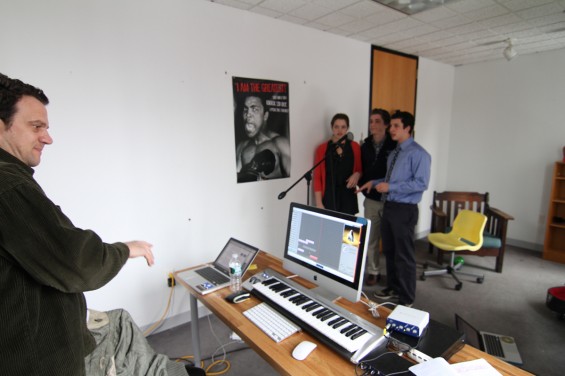
:rotate(0)/p39f1jed4mgd288myquiu5yecweg)